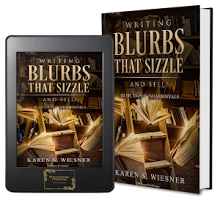Oldies But
Goodies
{Put This One on Your TBR
List}
Miss Hickory by Carolyn Sherwin Bailey
by Karen S. Wiesner

Beware potential spoilers!
The world was a very different place when Miss Hickory by Carolyn Sherwin Bailey was published in 1946. This was a children's novel, not a picture book with questionably well-done art accompanied by a sprinkling of words across the pages. Miss Hickory has 128 pages, 24,000 words. Back then, children were often read to by other people, usually parents. No doubt, many of these books were far beyond the child's own reading level yet the stories were perfectly understandable to them. The current suggested age for this book is 8 to 12, which boggles my mind a bit, and not simply because I can't imagine too many kids these days picking up a complex book like this. Additionally, back then stories like this one seemed to have a higher purpose than simply entertaining readers.
Miss Hickory was one of the very first books I ever read on my own as a child. With a protagonist who's a living doll made from a forked apple tree twig and a hickory nut for a head, her story was magical to me. Miss Hickory lived in a luxurious corncob house made by her owner Ann. Miss Hickory is used to being spoiled, but now things are changing. Ann is going away, and selfish Squirrel has decided he likes Miss Hickory's comfy house for his own winter home. Crow helps her find a nest where she can live out the winter, but she'll need to be clever and courageous to survive. The author and her husband lived on a farm with an apple orchard, and she drew inspiration for this story from there.
When I reread this enchanting story again recently, it was to the realization about just how prickly and hard-headed (sorry) Miss Hickory is. She likes to instruct people how best to live their lives but accepting help from others always leaves her irritated. And sometimes she misses out on wonderful things because of her stubbornness. Hilariously, she also likes be very feminine, and we find several chapters with Miss Hickory being a fashionista by making herself new and beautiful clothing out of things like maple leaves and grass and cherry blossoms. I found it interesting that Miss Hickory took the existence of God for granted. There's a Christmas miracle to be seen, but she misses it because she's too pigheaded to listen to anything Squirrel has to say. Does she learn her lesson through the many chapters in which she and her friends live out their lives on the farm? I'm not sure. But she does learn a lot about herself--her own origin, for one.
This story was told very strangely. Most of the chapters were from Miss Hickory's point of view, which made sense, as this is the compilation of her adventures during the seasons. However, sometimes we're put into the perspective of another (usually animal) character for no other reason I can fathom other than that the author felt she'd started a story with that particular character and needed closure before going back to Miss Hickory.
Though Squirrel plucks off and takes a bite of Miss Hickory's head (too scary for modern readers in both words and illustration? probably)--his character is suitably drawn with all the complexity needed for readers to find him endearing despite his actions. He's an animal designed for storing up food for himself, yet he can't seem to remember where he's hidden all his nuts from one minute to the next, let alone over the course of a long, harsh winter. And, frankly, wouldn't he much rather just eat it now? Of course he would! It's easy to root for all of these lovable, fully-fleshed out characters. Though the chapters play out in a seemingly random fashion, the story does actually reach full circle by the end.
I'd be remiss not to mention the lovely illustrations done by Ruth Chrisman Gannett. I found out they were done by a process called lithography, which is a really archaic (though there are still people who do it) means of photocopying something. Apparently, the artist has to be very careful while drawing on the stone (or similar material) as there are no second chances with this method. Either it's drawn right the very first time--or as close as possible--or a whole lot of time, effort, and materials will be wasted. Find out more about the art of this here https://jerwoodvisualarts.org/art-techniques-and-materials-glossary/lithography/ and be sure to watch some YouTube videos of it actually being done. I found it fascinating. Too much work, definitely, but still intriguing as a precursor to modern-day photocopying.
Inspired by the incredible artwork in Miss Hickory, I couldn't help wanting to do some sketches from the
book myself, which were all done by black and white lithography (although color
is possible with the method). I even did one in color, though only the cover of
the book has color in the first edition. Does anyone else want an apple now,
too? <grin>


Miss Hickory Black &
White Sketch and Colored Pencil Rendering by @Karen Wiesner

If you do an internet search with the words "Miss Hickory illustrations", you'll see some of Gannett's original designs, including one of Squirrel holding Miss Hickory's still scolding head just before he takes a bite of it. Never fear, Miss Hickory may end up headless, but she's also "heedless, happy" that way. Clearly, her head had been holding her back.
Children and adults alike will find a timeless, magical world to explore in this well-deserving Newbery Medal Winner. The lesson to be learned (as all these old books had some kind of moral to impart, which I heartily approve) is not to hold yourself back from who you're meant to be--not with the promise of comfort nor with the hurtle of fear of the unknown.
Karen
Wiesner is an award-winning, multi-genre author of over 150 titles and 16
series.
Visit her
website and blog here: https://karenwiesner.weebly.com/
and https://karenwiesner.weebly.com/karens-quill-blog and her publisher here: https://www.writers-exchange.com/Karen-Wiesner/



































